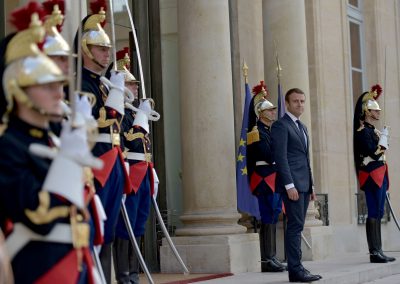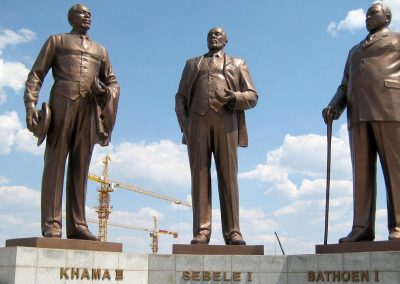
Empire Theory, Part I: Competitive Landscape
This is an excerpt from the draft of my upcoming book on great founder theory. Learn more here.
Empire Theory is a framework for understanding and practicing competitive strategy. Competitive strategy is the art of defeating opponents. Once you have chosen a domain of competition, good competitive strategy enables you to win.
Competitive strategy requires understanding how actors behave based on their position in a strategic landscape. This knowledge serves two clear purposes. First, by recognizing the patterns of these strategic players, it’s possible to infer a vast amount about the strategic landscape on the basis of relatively little evidence. Second, a deeper understanding of strategic moves and opponents’ incentives allows us to better craft our own competitive strategy, through predicting, planning for, and responding to behavior.
Empires
Here we use empire to mean a group of coordinated actors that operate around some central power. Coordinated actors are those people using discernible mechanisms for aligning their actions to achieve particular goals. A central power is an actor or set of actors causing others in a given region to coordinate. The actual central power may not be the ostensible central power; for example, a startup might be de facto run by its CTO rather than its CEO. An empire then, being a group of coordinated actors, will among those actors always have some kind of central power that is maintaining coordination. Let’s list some example empires to illustrate:
| Coordinated actors | Central power | |
| A company | Employees, business partners, customers | The CEO / executives |
| A government | The civil service, the military, corporations, citizens | The king / the president / the legislature |
| The Muskiverse | People at SpaceX, Tesla, Solarcity, and the Boring Company, perhaps others |
Elon Musk |
Empires are composed of players, resources, and other empires. Players are the individuals with enough power to be relevant to the overall functioning of the empire. Resources are assets that can be drawn upon for the empire to function. This category features many things besides physical resources, including money, information, and personal relationships. Coordination mechanisms — both natural and artificial — and people that are not sufficiently powerful to be relevant for the overall functioning of the empire are also considered resources. Finally, empires are fractal: empires contain other empires.
Fractality here is a key analytical lens. In the Catholic Church, for example, we could consider the coordinated actors to be the global Catholic clergy plus lay people, and the central power to be the leaders at the Vatican. However, it also makes sense to consider a single parish as an empire where the coordinated actors are the members of the parish and the central power is the priest. Likewise, a social movement like Effective Altruism could be considered an empire where the coordinated actors are the members of the movement and the central power is the cluster of people and organizations guiding the ideology and strategies of the rest. That said, an individual organization within the movement could also be considered an empire.
The fractal nature of empires follows from the fractal nature of coordination mechanisms. An empire can be identified either by noticing a group coordinating, or by identifying a coordination mechanism and then identifying the actors coordinated by that mechanism. As there will be different coordination mechanisms present in various parts of an empire, and thus sub-clusters of tighter coordination, empires will be fractal.
The Problem of Local Focus
In a given empire, the dynamics of the most central sub-empire have a large effect on the rest of the empire, and control of the central sub-empire is important to top strategic players as it yields control of the rest of the empire. As a result, the top players in an empire tend to prioritize controlling the central sub-empire. This phenomenon repeats in a fractal manner. To illustrate, consider the United States an empire, and the president of the United States a player seeking to control the empire. Within the United States, let’s say the central sub-empire is the executive branch. Within the executive branch, let’s say the central sub-empire is the cabinet. If the president cannot control the cabinet, then it will be much more difficult for him to control the executive branch. If he cannot control the executive branch, then it will be much more difficult to control the United States government.
A great deal of resources then tends to be spent on control of the central sub-empire. This allocation of resources detracts from the proper functioning of the rest of the empire and hurts the empire’s expansion, as more resources spent on central infighting means fewer resources spent on other things essential to the empire’s functioning. Unfortunately, this outsized expenditure is not the result of corruption and whimsy, but political necessity — a lot of what we usually call “corruption” stems from political necessity. This problem of local focus is one of the strongest limiting factors on the sizes of empires, because the problem tends to get worse as an empire gets larger. The problem of local focuses increases in larger empires because the more power an empire has, the more skilled players are attracted to it. The more skilled players are attracted to a given empire, the more difficult it is to control the central sub-empire. The more difficult it is to control the central sub-empire, the more difficult it is to preserve and expand the empire. As a result, the problem of local focus hugely limits the expansion of empires.
When examining an empire, it is always worth asking whether some inexplicable move or event is in fact best explained not by the dynamics and interests of the empire as a whole, but by the dynamics of the most central sub-empire. This will frequently reveal that global moves, which may seem inexplicable on the global scale, have their origins in local problems that are comparatively trivial. For example, many great empires in history were limited simply by the untimely illnesses of their core leaders, often giving rise to opaque power struggles for succession with great rippling effects. Another example might be the Cultural Revolution in China, which had massive consequences for hundreds of millions of people, but was instigated by Chairman Mao simply in order to buttress his position of power in the leadership of the Communist Party of China.
Power Classes
The coordinated actors in an empire will have differing amounts of power. For example, consider a tech startup as an empire. The founder can hire and fire people, will usually play the lead role in determining the startup’s strategy, and can contribute directly to the creation of the company’s product. In contrast, a newly hired programmer may only be able to contribute to the product. As such, the founder has more power in the empire than the newly hired employee. Power classes are a typology of the coordinated actors in an empire distinguished on the basis of their relative power levels.
Like empires, power classes are fractal. The same actor can be classified as Low, Mid, or High depending on the frame of reference. For example, a parish priest in New York might be low if considering the entire Catholic church, mid if considering the Archdiocese of New York, and high if considering the priest’s parish itself.
High is the central power that defines an empire’s zone of coordination. Without high, the empire would not exist and the other actors would not be coordinated. High also plays the largest role in determining the distribution of resources within the empire. High can be an individual (e.g. a forceful CEO) or a group (e.g. the board of directors of a foundation). It will often make sense to model high as an empire in itself, because there are naturally occurring coordination mechanisms that cause high to be its own cluster of coordination within an empire, and there are usually a small number of individuals in high that coordinate the other high players — a high within high. These natural coordination mechanisms include the pressure resulting from the fact that high players are mutually threatened by middle players and by aggressive outside empires.
Mid is the collection of individuals or groups that have sufficient power to challenge high’s control. Mid players will often have smaller empires of their own. Mid plays an important role in constraining the action of high. In our tech startup example, mid players might be the managers of the engineering and sales teams. It does not usually make sense to model mid as a single empire. They are very seldomly coordinated as such.
Because mid players control fewer resources than high players, any mid player will have to expend a greater portion of their resources to secure the coordination of a fellow mid player. An investment of $1 million is a notable and risky venture when your net worth is $20 million. It might be an afterthought if your net worth is $2 billion.
Since each individual mid player controls notably fewer resources than high, you have to coordinate more of them to reach the same capabilities that a single high player can provide. Coordination costs are superlinear, so pooling anything except the simplest resources in this way is uneconomical. Coordinating thirty different strategic players rather than three is likelier to increase costs by a factor of one hundred rather than of ten.
For any given mid player, high is usually a preferable ally to other mid players. Given these known problems and the existing uncertainty in mutual evaluation, a mid player must then not only match, but outbid the offer made to mid by high. This event occurs infrequently.
Low is the collection of players that can challenge mid but cannot challenge high. Low has the largest population and the least power. In our tech startup example, the low players would be individual programmers or sales people. The programmers on an engineering team could plausibly challenge their manager, but they could not plausibly challenge the founder. Like mid, it does not make sense to model low as an empire.
Outside is any actor that is not coordinated by the high power. In our example, this could be the CEO of a competing company or the mayor of a town in France. Outside players may still seek to affect an empire, including by meddling in its internal affairs. It is also possible to further subdivide outside into near and far. The CEO of a competing company might be considered near, whereas a mayor of a town in France would be far.
As mentioned earlier, certain actors are best modeled as resources. Any actor that cannot independently challenge mid is best understood as a resource, because these actors will not be relevant for understanding the empire. They can be understood as resources, because they will be used by low, mid, and high players to accomplish their objectives. For example, they might provide labor or be weaponized by players against each other.
Examples of classifying by Power Class
In the United States today, high is best understood as being composed of key federal agencies. Heads of major institutions such as large companies, banks, universities or governors of individual states can be understood as mid. State officials, heads of local groups and smaller organizations can be understood as low. Everyone else is best modeled as a resource. Relevant outside powers consist of key foreign governments such as China or Russia.
At Harvard University, perhaps high is occupied by the president, provost, deans, vice presidents, or trustees. Mid might be key professors, long-time staff, heads of departments, and major donors. Low might be student organizers or less important professors. Other students, assistant professors, replaceable staff, and smaller donors might be resources. Relevant outside players might be companies that recruit from the university or the local city government.
The official story of who is and is not powerful does not always match the actual story. For example, it might be that the president of Harvard has only moderate internal influence and that one of the deans has by far the most internal influence. In this case, the president might be better classified as a mid player. When assigning individuals and groups to power classes in an empire, be skeptical of your assessments, as it is easy to assume power distributions based on the official story.
Strategic Landscapes
A strategic landscape is a domain of competition among players. A domain of competition is a region in which players compete for scarce resources.
Trying to analyze a strategic landscape without specifying a domain of competition will yield confusion and error. If the domain of competition isn’t specified, ends and means cannot be distinguished. Most actions are ambiguous, so unless they are interpreted through a definite hypothesis, investigation has no clear direction and uncertainty cannot be resolved.
This approach distinguishes the mere accumulation of facts from analysis. The crucial task is determining which facts are relevant and prioritizing them. While you might imagine a logistical analysis that doesn’t specify a domain of competition, it will fail to predict the range of interactions between players.
You might correctly note the industrial capacities in a particular region, but if you are not keeping track of whether the factories are aligned either through an owner, a state, or an oligopoly, you will fail to predict which products can be built or which projects will be carried out.
Since players can modify any mere logistical fact, the accumulation of facts without knowledge of the domain of competition will perhaps correctly show the functioning of some systems but will fail to predict changes in the system.
For example, analyzing the strategic landscape that includes the oil industry and the social justice movement without specifying a resource they are competing over will result in something like a list of reports of media events and general beliefs. To understand their dynamics or even correctly evaluate the facts on the ground you have to identify either a definite conflict point, or their overall strategic aims and position. You might, for example, begin to analyze them as part of a political strategic landscape in which the resource competed over is the allegiance of a particular congressman.
The oil industry might have the ability to offer positive resources in the form of financial or legal support for the congressman, their purpose for competing in the political landscape being favorable legislation for their industry. The social justice movement might be able to mount a campaign against the congressman, attacking their character, their purpose being social reform, perhaps through legislation.
The oil industry might have the ability to offer positive resources in the form of financial or legal support for the congressman. Their purpose for competing in the political landscape being favorable legislation for their industry. The social justice movement might be able to mount a campaign against the congressman, attacking their character. Their purpose being social reform, perhaps through legislation.
In the competitive scenario laid out it would only make sense for an unpopular or weak congressman to go with social justice, and only temporarily, since all the social justice movement can offer is to stay its hand, while the oil industry can provide useful resources that improve the congressman’s long term position.
Empires are domains of competition, and domains of competition tend to be empires; empires are always domains of competition in which players are competing for power, and domains of competition almost always have coordinating mechanisms binding the competitors together (for example, competitors in the oil industry coordinating to defeat clean-air legislation).
The term “landscape” provides a useful metaphor for thinking about these domains of competition. You can think of the terrain of a strategic landscape as being determined by the competitors and their relative power. Imagine yourself standing on a precipice overlooking a strategic landscape of a university. You see rolling hills off to the left, some of which are larger than others, representing the heads of the various humanities’ departments. In the middle is a tower mountain representing the central administration, upon which there is a high rocky outcrop representing the president of the university. The landscape is not static, but dynamic, with the terrain shifting as players make moves and gain or lose power. If you want to compete in this strategic landscape, you will have to navigate it, taking into account the powers of the other players in determining your path, your competitive strategy. The same goes for the other competitors.
Patterns of power
Earlier I claimed that actors exhibit common patterns of behavior depending upon their relative position in a strategic landscape. Now we can parse this: in a domain of competition, aspects of the behavior of high, mid, and low players will be consistent and recognizable. This means, for instance, that there are patterns of interaction between high and mid, and that, if we identify high and mid in a particular domain, we will immediately learn much about how those players will behave. The common behaviors of players are a consequence of what works and does not work for players given their position on the landscape. Understanding such patterns thus substantially broadens one’s range of available strategic options. We will explore these dynamics in detail in part two.





